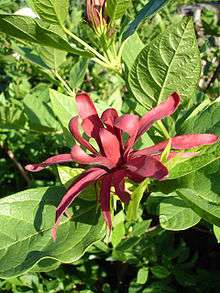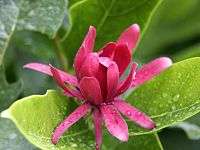Calycanthus
| Calycanthus | |
|---|---|
 | |
| Calycanthus floridus | |
| Scientific classification | |
| Kingdom: | Plantae |
| (unranked): | Angiosperms |
| (unranked): | Magnoliids |
| Order: | Laurales |
| Family: | Calycanthaceae |
| Genus: | Calycanthus L. |
| Species | |
|
C. floridus | |
Calycanthus (sweetshrub)[1][2] is a genus of flowering plants in the family Calycanthaceae, endemic to North America. The genus includes two to four species depending on taxonomic interpretation; two are accepted by the Flora of North America.
Description
Calycanthus plants are deciduous shrubs, growing 1–4 metres (3.3–13.1 ft) tall and wide. The bright green leaves are opposite, entire, 5–15 centimetres (2.0–5.9 in) long and 2–6 centimetres (0.79–2.36 in) broad.
The bark has a strong camphor smell that is released when stems are scraped.[3] The smell remains strong on twigs that have been stored several years in a dry environment.
The strongly scented flowers are produced from late spring through early autumn for Calycanthus occidentalis, and April to July for Calycanthus floridus.[4] They are 4–7 centimetres (1.6–2.8 in) broad, with numerous dark red to burgundy to purplish brown tepals. Typical of the Calycanthaceae family, the flowers lack distinct sepals and petals, but instead have distinct spirals of tepals.
The lotus-shaped flowers can resemble a small magnolia flower. They are pollinated by beetles in the Nitidulidae family.[5]
The fruit is an elliptic dry capsule 5–7 cm long, containing numerous seeds.
Species
- Calycanthus floridus—Carolina spicebush, eastern sweetshrub. Native to the Eastern United States, from New York and Missouri, south through the Appalachian Mountains, Piedmont, and Mississippi Valley, to Louisiana, and east to northern Florida.[6]
- Calycanthus occidentalis—California spicebush, western sweetshrub. Native to moist habitats of California below 1,500 metres (4,900 ft), including in the California Coast Ranges, San Joaquin Valley, and Sierra Nevada.[9][10]
- Related
- Sinocalycanthus chinensis (Calycanthus sinensis)—Chinese sweetshrub, Chinese wax shrub. Native to eastern China, with white flowers. First described in 1963 as Calycanthus chinensis. Sinocalycanthus is a monotypic genus in the family Calycanthaceae.[11]
 Calycanthus occidentalis—western sweetshrub
Calycanthus occidentalis—western sweetshrub Calycanthus floridus—eastern sweetshrub
Calycanthus floridus—eastern sweetshrub
Uses
Medicinal plant
Both species of Calycanthus were used as a traditional medicinal plant by Native Americans. The indigenous peoples of California also used Calycanthus occidentalis in basket weaving and for arrow shafts.[12] [13]
Cultivation
Both Calycanthus species are cultivated as ornamental plants by plant nurseries, including in the United States and England.
Calycanthus occidentalis is planted in traditional, native plant, and wildlife gardens, and for natural landscaping and habitat restoration projects, primarily in California and the Western United States.[4][5][14][15] It was introduced into cultivation in 1831.[4]
Calycanthus floridus is also planted in gardens, as a specimen shrub or for hedges.[16][17]
It was noted by Mark Catesby in the Piedmont woodlands of the British Province of Carolina in 1732. He described it, with its bark "as odoriferous as cinnamon", but did not name it.[18] The colonial planters of the Carolinas transplanted it into their gardens, and the botanist Peter Collinson described it to Linnaeus and imported it into England from Charleston in the Province of South Carolina around 1756.[19]
Essential oils
Calycanthus oil, distilled from the flowers, is an essential oil used in some quality perfumes.[20] The flowers of Calycanthus occidentalis have a spicy sweet scent. The flowers of Calycanthus floridus were compared to a bubble gum scent by one reference.[21]
References
- ↑ Flora of North America: Calycanthus
- ↑ USDA Plants Profile: Calycanthus
- ↑ Calycanthus floridus. from Plants for a Future
- 1 2 3 Lady Bird Johnson Wildflower Center Native Plant Information Network-NPIN: Calycanthus occidentalis (Western spicebush)
- 1 2 Las Pilitas Horticulture database: Spice Bush−Calycanthus occidentalis
- ↑ USDA: Calycanthus floridus distribution map
- ↑ USDA: Calycanthus floridus var. floridus
- ↑ USDA: Calycanthus floridus var. glaucus
- ↑ Jepson Manual (TJM93) treatment of Calycanthus occidentalis
- ↑ USDA Calycanthus occidentalis distribution map
- ↑ Arnold Arboretum, Harvard University: "Presenting Sinocalycanthus chinensis-Chinese Wax Shrub; Gerald B. Straley, 2014.
- ↑ University of Michigan at Dearborn, Native American Ethnobotany database: Calycanthus floridus (California spicebush)
- ↑ University of Michigan at Dearborn, Native American Ethnobotany database: Calycanthus occidentalis (Carolina allspice)
- ↑ Theodore Payne Foundation, California Native Plant Horticulture database: Calycanthus occidentalis - Spice Bush
- ↑ Missouri Botanical Garden, Garden Help: Calycanthus occidentalis
- ↑ Lady Bird Johnson Wildflower Center Native Plant Information Network-NPIN: Calycanthus floridus (Eastern spicebush)
- ↑ Missouri Botanical Garden, Garden Help: Calycanthus floridus
- ↑ Catesby, The Natural History of Carolina (1732).
- ↑ Coats (1964) 1992.
- ↑ Groom, N. The New Perfume Handbook, second ed., Springer, 1997, page 48.
- ↑ iVillage Garden Web: "Which shrubs smell good list"
External links
| Wikimedia Commons has media related to Calycanthus. |
- CalFlora Database: Calycanthus occidentalis (spicebush, western sweetshrub)
- Jepson eFlora (TJM2) treatment of Calycanthus occidentalis
- USDA Plants Profile for Calycanthus genus
- UC Photos gallery: Calycanthus floridus
- UC Berkeley Cal Photos gallery: Calycanthus occidentalis